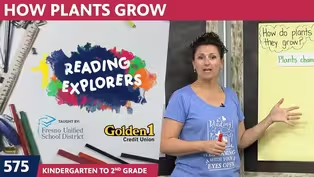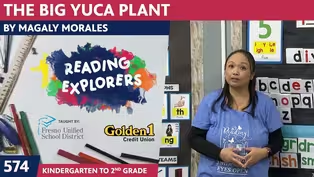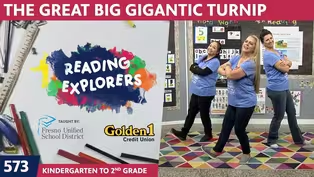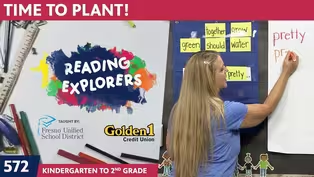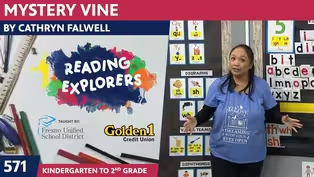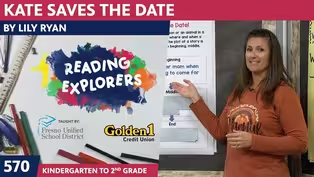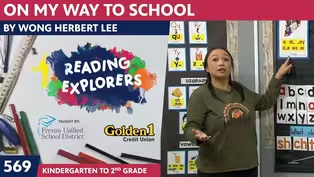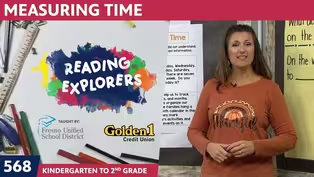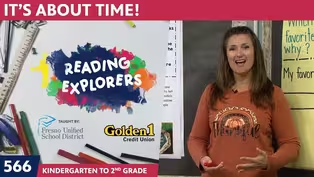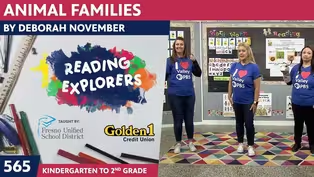
3-322: The Meaning of Homophones
Season 3 Episode 112 | 14m 13sVideo has Closed Captions
Join Mrs. Nix at Camp Discovery!
Third Grade teacher, Mrs. Nix, welcomes students back to Camp Discovery, a fun learning space packed with reading adventures & fun games!
Problems playing video? | Closed Captioning Feedback
Problems playing video? | Closed Captioning Feedback
Reading Explorers is a local public television program presented by Valley PBS

3-322: The Meaning of Homophones
Season 3 Episode 112 | 14m 13sVideo has Closed Captions
Third Grade teacher, Mrs. Nix, welcomes students back to Camp Discovery, a fun learning space packed with reading adventures & fun games!
Problems playing video? | Closed Captioning Feedback
How to Watch Reading Explorers
Reading Explorers is available to stream on pbs.org and the free PBS App, available on iPhone, Apple TV, Android TV, Android smartphones, Amazon Fire TV, Amazon Fire Tablet, Roku, Samsung Smart TV, and Vizio.
Providing Support for PBS.org
Learn Moreabout PBS online sponsorshipMore from This Collection
Valley PBS and Fresno Unified School District have partnered with Golden 1 Credit Union to create Reading Explorers Lessons for grades Pre-Kindergarten through Third grade. The daily lessons will be taught by Fresno Unified School District teachers and are created to help students practice their reading skills and reinforce lessons during distance learning.
Video has Closed Captions
Learn about the life cycle of a plant on Reading Explorers. (26m 39s)
K-2-574: The Big Yuca Plant by Magaly Morales
Video has Closed Captions
Join the Reading Explorers as we adventure into a new book The Big Yuca Plant. (26m 30s)
K-2-573: The Great Big Gigantic Turnip
Video has Closed Captions
What will happen at The Great Big Gigantic Turnip? (26m 30s)
K-2-571: Mystery Vine by Cathryn Falwell
Video has Closed Captions
The Bell has rung and the Valley PBS Classroom is open once more. (26m 32s)
K-2-570: Kate Saves The Date by Lily Ryan
Video has Closed Captions
Mrs. Nix, Mrs. Hammack and Mrs. Vang are glad to have you join her for a new day. (26m 32s)
K-2-569: On My Way To School by Wong Herbert Lee
Video has Closed Captions
Mrs. Vang is ready for a new day of phonemic awareness and reading comprehension. (26m 40s)
Video has Closed Captions
We review phonics, frequency words and more on Reading Explorers. (26m 45s)
K-2-567: Nate The Snake Is Late
Video has Closed Captions
What happens when Nate the Snake is late to school? (26m 49s)
Video has Closed Captions
It's time for school! How do you know what time it is? (26m 31s)
K-2-565: Animal Families by Deborah November
Video has Closed Captions
Welcome to the Reading Explorers lessons in the Valley PBS Classroom. (26m 14s)
K-2-564: From Caterpillar To Butterfly
Video has Closed Captions
The transformation from Caterpillar to Butterfly is a special one. (26m 52s)
Providing Support for PBS.org
Learn Moreabout PBS online sponsorship(cheerful guitar music) ♪ Good morning to a brand new day ♪ ♪ Time to learn and games to play ♪ ♪ Learning things is so much fun ♪ ♪ Learning is good for everyone ♪ (cheerful guitar music) (upbeat music) - Good morning, third grade.
My name is Mrs. Nixon.
I am so excited to be here with you to support you as we become amazing thinkers, readers, and writers.
I have with me another book on Abraham Lincoln, just because, it's the week that we're celebrating his birthday, and so we have Presidents' Day.
So this particular one is called, "Looking at Lincoln," and it goes through and tells us the whole story of Abraham Lincoln and all of his life.
And I think that you really gonna discover what an unforgettable man he truly was.
Don't believe me?
Check out that $5 bill.
Every time you see that $5 bill, I bet you think of President Lincoln.
So, how do we check out books like this and others?
It's super easy, you can do it by visiting your local county library, or you can go online and search through all the many titles that are found on Sora.
It's a free app.
And in Fresno Unified, we love to count down our schools that are checking out books using Sora.
Okay, let's look and see who our top schools are just this last week.
So in fifth place we had Hoover, and in fourth place we had Turner Elementary.
So great job Turner Elementary.
If you would love to see your school here on our countdown of the Top Checkout Schools in Fresno Unified, it's super easy to do.
All you do is check out a book on Sora, and possibly tell a classmate, or two, or three (laughs) to do the same, and then your school can be up here.
The other thing that I'd love to point out to you is that we have here at PBS, some super fun activity books.
You're gonna see an address pop up on the screen down below, and that's all you need to do, is send me a note in the mail, and I'll put one of these free activity books for you in the mail.
Let me know something that you're learning, something that you've learned on PBS, or maybe it's a book that you've been reading, and you would love for me to share the title of that book with all of the other third graders in our valley.
I'd love to do that.
All right, are you ready to start, third grade?
Okay, let's do it.
I've got three things we're practicing this week.
We're gonna be going over our homophones, our R-controlled syllables, and then we're gonna finish up with some comprehension, looking at multiple-meaning words.
Okay, let's warm up those brains, looking at those high-frequency words and get things going.
Join me.
Let's do this.
All right, big and loud, read them at home.
Their, there.
Them, then.
These, they.
Things, think.
This and those.
Nicely done.
Today I have two of them that we are gonna focus on.
We have them and then.
So them is T-H-E-M, and then is T-H-E-N. All right, help me put them in a couple of sentences.
So the first one here, read it with me.
Eat your breakfast mm brush your teeth.
Hmm?
Can you think about what goes there?
All right, I have an idea.
She went with mm to the park.
Oh, she went with then?
That wouldn't sense.
But I bet she went with them to the park, meaning she went with some friends, right?
Or maybe they were family.
And eat your breakfast then brush your teeth 'cause sometimes it doesn't make sense to brush your teeth and then eat breakfast, 'cause then your teeth are dirty, right?
All right.
Okay, boys and girls, let's start our, what we're gonna practice today.
Let's start by looking at some R-controlled syllables.
Now, just a reminder, those R-controlled vowels or those bossy R's, sometimes our teachers'll call them.
I kind of put a little cheat note here for us, just remember, it's A-R, E-R, I-R, O-R, that O-R-E, U-R, those are those R-controlled vowels.
Whenever you see them in a word, we're never gonna split them.
You treat them just like they are a vowel sound.
So when we're looking for our syllables, and we're splitting our words into syllables, we're looking for the vowels.
So I've marked the E-R.
I've highlighted that in red, so we can really see it bright.
We've got a vowel over here,.
And when there's two consonants in the middle, we know we can split it.
So this word is ham mer, and so we know we have two syllables there.
This word here, charming, so I've got a vowel sound here, that A-R is gonna be our vowel sound.
And then ing has that kind of that I sound, the short I sound.
So charm ing, we've got two syllables there.
I'm gonna just kind of put it a little bit of a space, so you can see it.
Charm ing, just like that.
And we're gonna do a little bit of practice.
Okay, I wanna switch gears though, and I wanna talk about homophones.
And when every time you see that word homophone, I want you to take your hand, just like you've got a telephone in your hand, and I want you to put it up to your ear.
So that you can remember that homophones has to do with sound.
It's something that you hear.
So when you hear homophone, you're thinking about a phone, and you're thinking about the sound.
So homophones are words that sound alike, but are spelled differently and have different meanings.
Okay, so let's look here.
I've got some homophones, two, too and to, they all sound the same but look at them.
They're all spelled differently.
Two, T-W-O, is the number two, like I have two dogs.
Too, as in T-O-O, actually is a multiple-meaning word, but it can mean in excess, or it can also mean also.
So you could replace it with the word 'also.'
And then the last one, T-O, is simply expressing motion in the direction.
So I'm going to my bedroom.
All right, so let's look down here.
We're gonna put the word 'two' in all of these blank spots.
So two of my friends will go to the store, too.
Okay, so let's think about this.
If I'm gonna say two of my friends that means I'm talking about the number two, right?
So two of my friends will go to the store.
Well, this is expressing direction.
All right.
Two of my friends will go to the store too, so that's like almost saying also, right?
They're gonna go also.
That's a great way to remember it.
All right.
Excellent job, let's go through and let's practice some of these skills.
So up here, we've got some homophones that we're gonna go through and practice.
So we've got the homophones, your, now there's two different ways.
And remember we talked a little bit yesterday, anytime you see that contraction, break it apart and say both words.
Use it in a sentence.
So I'm gonna use, 'you are' in this sentence to see if it fits, I think you are report was very interesting.
Did that make sense?
No, so when I say 'your report,' I think your report was very interesting, I know that I'm just gonna put Y-O-U-R.
It belongs to you.
All right.
Now we've got road.
Road and rowed.
This is like a road, like a street, and this would be rowed like you're rowing a boat.
Let's see which one fits.
We slowly rowed the canoe down the river.
What's a canoe?
It's a boat, right?
So if we're rowing, we wanna say we rowed the canoe.
Excellent.
Do you think, we've got 'their' or 'they are,' going to be here on time?
Okay.
So let's try it with the contraction 'they are.'
Do you think they are going to be here on time?
Did that make sense?
Yes, so this would be they're with, written as the contraction.
Excellent.
Last one, I found the missing piece of the jigsaw puzzle.
Which piece?
Okay.
This is where again, like I said, you're going to have to practice and experience by reading and writing, and that will help you to remember that piece, P-I-E-C-E, is spell, means that it's a portion of it.
Okay, down below we're gonna underline the word that has the R-controlled vowel syllable and then circle the two letters that make that R-control vowel sound.
Okay, so let's look.
We've got people, really and person.
Do you see any of the words here that have the R-controlled vowel?
Yes, right here is that R-controlled, E-R. Good.
All right, let's look again.
Sharpen, slowing and safety, do you see an R-control?
Yep, I see it in sharpen.
Where is it at?
Do you see it?
Yeah, right there, A-R. Good.
How about willow, working and waiting?
Okay, good.
It's in working, and where is it at?
You got it, the O-R is right there.
Okay, excellent job.
Let's go over, and I wanna spend a little bit of time today talking about and practicing multiple-meaning words because, and I think that this is excellent that we're gonna talk about multiple-meaning words on the same time that we're talking about homophones because they can get a little confusing.
Multiple-meaning words, yes, they do sound the same.
In fact, they're even spelled the same.
Homophones aren't spelled the same, okay?
So that's kind of the difference.
So multiple-meaning words, a multiple meaning word is a word that can mean something entirely different even if it's spelled the same and pronounced the same.
So here's an example, let's look at the word 'test.'
Now the word 'test' has a couple of different meanings.
Test could be to measure.
'Kay?
I'm gonna measure something.
It can also be an exam, or like a quiz.
So both of these, both of these definitions, can apply to the word 'test.'
Now, today what I want us to do is I want us to look at a sentence using the word 'test.'
And then you're gonna help me decide what definition best fits that word 'test.'
Okay, let's go through and let's read it together.
You read it big and loud.
The kite was first made in China.
This was 2,400 years ago.
Some used kites for fun.
Some used them to test the weather.
Okay, so here's my question, test the weather.
Are we giving the weather an exam?
Probably not, I don't think that the weather could do an exam, but do you think that we were measuring the weather?
Were they sending out a kite to test the weather?
Absolutely, so it would be to measure.
That's a great example of how that was used.
All right, multiple-meaning words, homophones, and R-controlled vowels are all of the things that we went through today.
And I encourage you, as you are reading, see if you can find some of those multiple meaning words.
See if you can find some homophones.
I bet you can.
All right, I wanna say thank you so much for hanging out with me this morning, as you're getting ready for school.
And to remember.
you are responsible for your learning success.
So listen, ask questions, and share your ideas, because together, we can do so much more.
Have a fantastic day, and I can't wait to see you back here at PBS tomorrow.
Have a good one.
Bye-bye.
(cheerful guitar music) ♪ Good morning to a brand new day ♪ ♪ Time to learn and games to play ♪ ♪ Learning things is so much fun ♪ ♪ Learning is good for everyone ♪ (cheerful guitar music)
Support for PBS provided by:
Reading Explorers is a local public television program presented by Valley PBS
